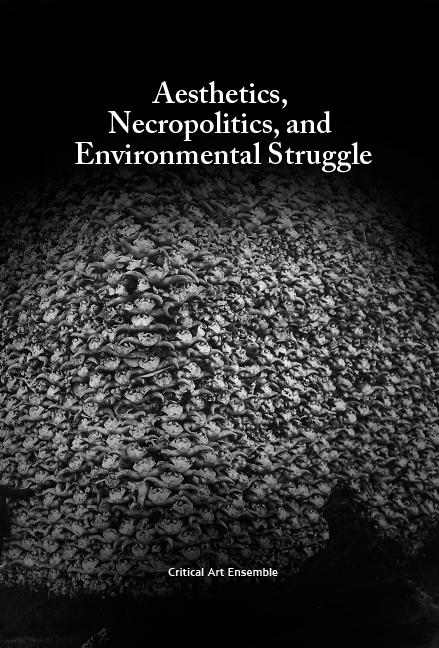Critical Art Ensemble: Aesthetics, Necropolitics, and Environmental Struggle (2018)
Filed under book | Tags: · aesthetics, anthropocene, biopolitics, climate crisis, environment, necropolitics, politics

“With typical sangfroid, CAE dissects the beast of our own making: the Anthropocene. Clarifying the philosophical roots of the Euro-American confusion about nature, this text offers severe and essential medicine for coming to terms with our ecological predicament.” –Claire Pentecost, professor, School of the Art Institute of Chicago
“This book presents a perspective about the environmental crisis that I suspected was there but couldn’t put my finger on. Follow these authors deep into one of the biggest cultural lacunas of our day: necropolitics. This book fully abandons solutionist bull in favor of a measured approach grounded only in what we know. Read it, weep, and then kick ass. Once again, CAE has blown my fucking mind.” –Mike Bonanno, The Yes Men
Publisher Autonomedia, Brooklyn, NY, 2018
Anti-copyright
ISBN 1570273375, 9781570273377
167 pages
PDF (pages 120-127 missing)
PDFs
The Distance Plan (2013–)
Filed under magazine | Tags: · anthropocene, art, climate, climate crisis, earth, environment
![]()
“The Distance Plan is a project founded by Abby Cunnane and Amy Howden-Chapman that brings together artists, writers and designers to promote discussion of climate change within the arts. The Distance Plan works through exhibitions, public forums and the Distance Plan Press which produces publications, including an annual journal.”
“The issue 4 features artist pages by Louise Menzies and Michala Paludan, an essay by Lina Moe on the closure of New York’s L Line, and, through our ongoing Climate Change & Art: A Lexicon, surveys the language currently surrounding anthropogenic climate change. Through proposing neologisms and promoting less well-known terms, we wish to propel interdisciplinary discussion, and by extension accelerate the pace of action.
Through this lexicon we propose that the science around climate change is developing so rapidly that we need new language to articulate its processes and effects. The lexicon is also based on the recognition that evolving science produces evolving policy, and politics must be commensurate with this. The first set of lexicon terms were collected in the Reading Room journal in 2015.”
Edited by Amy Howden-Chapman and Abby Cunnane
Publisher Distance Plan Press, Auckland, New Zealand
Creative Commons BY-NC-SA 4.0 International Licence
ISSN 2463-5553
127 pages (Issues 2 & 4), 135 pages (Issue 3), 69 pages (Issue 5)
Issue 1, 2013: PDFs
Issue 2: Seven Conversations, 2014: PDF, PDFs
Issue 3: Climate & Precarity, Dec 2015: PDF, PDFs
Issue 4: Climate Change & Art: A Lexicon, Oct 2016: PDF, PDFs
Issue 5: Charismatic Facts: Climate Change, Poetry & Prose, Apr 2019: PDF, PDFs (added on 2019-5-30)
Jennifer Gabrys: Program Earth: Environmental Sensing Technology and the Making of a Computational Planet (2016)
Filed under book | Tags: · citizenship, city, climate crisis, computation, data, earth, ecology, environment, experience, individuation, participation, sensors, technology, urbanism

“Sensors are everywhere. Small, flexible, economical, and computationally powerful, they operate ubiquitously in environments. They compile massive amounts of data, including information about air, water, and climate. Never before has such a volume of environmental data been so broadly collected or so widely available.
Grappling with the consequences of wiring our world, Program Earth examines how sensor technologies are programming our environments. As Jennifer Gabrys points out, sensors do not merely record information about an environment. Rather, they generate new environments and environmental relations. At the same time, they give a voice to the entities they monitor: to animals, plants, people, and inanimate objects. This book looks at the ways in which sensors converge with environments to map ecological processes, to track the migration of animals, to check pollutants, to facilitate citizen participation, and to program infrastructure. Through discussing particular instances where sensors are deployed for environmental study and citizen engagement across three areas of environmental sensing, from wild sensing to pollution sensing and urban sensing, Program Earth asks how sensor technologies specifically contribute to new environmental conditions. What are the implications for wiring up environments? How do sensor applications not only program environments, but also program the sorts of citizens and collectives we might become?
Program Earth suggests that the sensor-based monitoring of Earth offers the prospect of making new environments not simply as an extension of the human but rather as new “technogeographies” that connect technology, nature, and people.”
Publisher University of Minnesota Press, 2016
Electronic Mediations series, 49
ISBN 9780816693122, 0816693129
x+357 pages
via publisher
Reviews: Etienne S. Benson (Am J Sociology, 2017), Matthew W. Wilson (Cultural Geographies, 2017).
Interviews: Rorotoko (2016), Ulrik Ekman (Computational Culture, 2017).
Author (with links to related articles)
Publisher
WorldCat
PDF (6 MB)
Comment (0)
